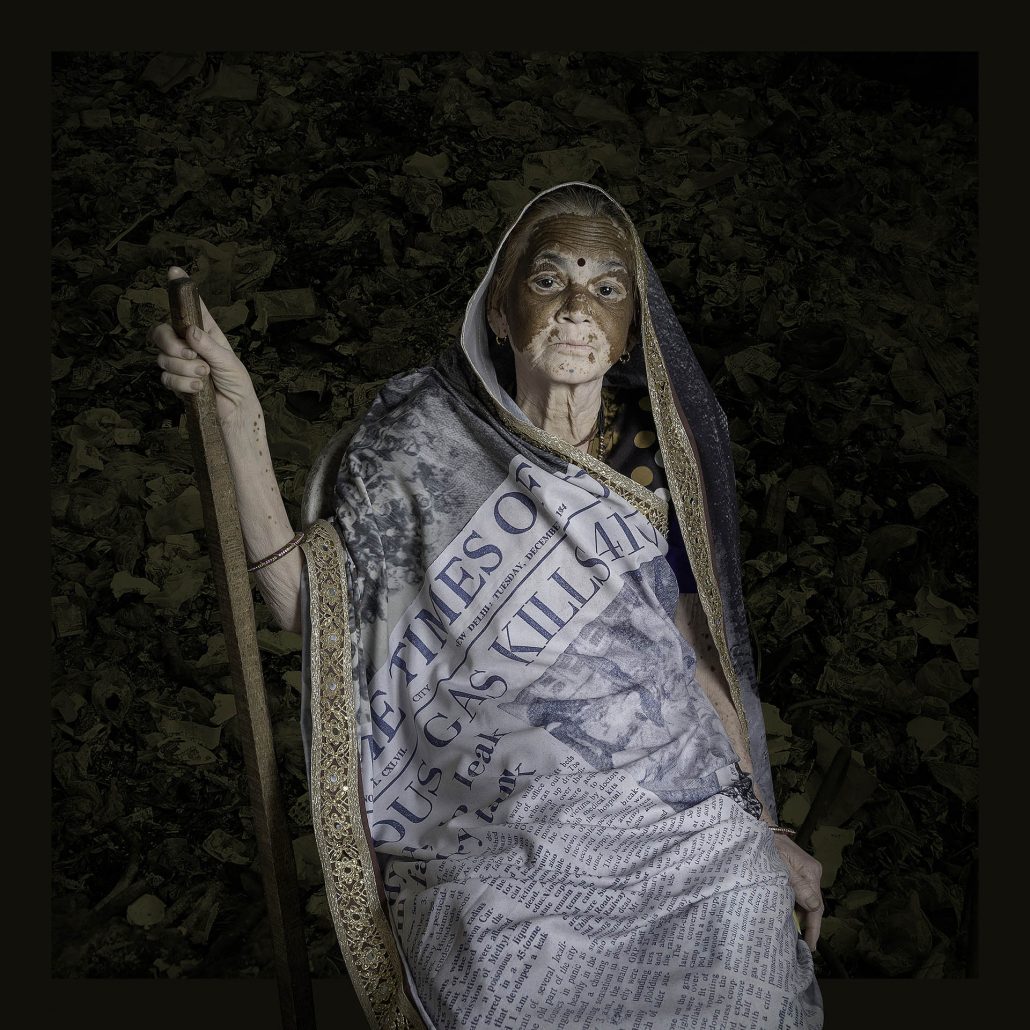India, 2017-2018
This post is also available in:
 French
French
Bhopal is like a tattoo on their skin. Should I really have given them these saris, printed with press cuttings reporting on that night in December 1984 when a lethal gas escaped from the Union Carbide chemical plant, spreading stealthily through the town, or printed with X-rays of victims where you can see the silent injuries, leaving their bodies exhausted, or printed with the skeleton of the factory standing immobile like a statue, or printed with views of the surroundings, where, absurdly, families were out enjoying picnics as if nothing had happened ? They laid them out, chose amongst them, put them on and looked at me, or preferred to show me just their backs, simple silhouettes like a frozen image.
I photographed the town, the interiors of the houses where life went on because it had to, and the patients in clinics where they try to treat what can be treated. I went back into what it is left of the factory. I rummaged through archives, found the warning letters dated from before the explosion, I heard the cries of anger and the resigned silence. I took my time. And I got to like these women standing tall.
They accepted to wear Bhopal on their skin. They are seeking compensation for the 3500 deaths on the night of the catastrophy and for the 200 000 more that were added as the years went by. They protest in the streets demanding that the authorities clean up the site which continues to pollute the area. They suffer too, but don’t complain because life has to go on. The coloured embroidery on the hem of the saris underscores the fact that they are still women. Even inside the most modest homes I could see that delicate touch which is also a silent battle. These images remind us of what Bhopal was and what this Indian town is today, whose name will forever be associated with a chemical catastrophy which could have been avoided.
So yes, I was right to have given them the saris. Wearing them is a gesture of defiance and I’m delighted that they look well for the fight.
2019 marks the 35th anniversary of the catastrophy. It continues to kill and the number of victims continues to rise, even though it is hardly ever in the news any more.
Isabeau de Rouffignac, a graphic artist by trade, worked for many years in an agency before turning independent, discovering photography at the turn of the millennium. It was a revelation, and soon became more than just a hobby. Since then, she shoots worlds that are far away or close to home, with an approach situated somewhere between documentary and art. Her guiding principle, which runs throughout her work giving coherence to her opus: approach the subject, develop a relationship, learn the language, take time, become invisible.
For the past few years she has been fully dedicated to photography and explores the complexity of other cultures which she looks on in a very personal way, with curiosity and empathy. It was in this way that she followed an Indian postman on his rounds in the desert, discovered traditional akha medicine and documented the ethnic akha population in Thailand, and tracked the vestiges of the Khmer Rouge genocide in Cambodia.
Isabeau de Rouffignac uses photography in a silent revolt to highlight the plight of the weakest members of society. Her most recent project, in Bhopal, India, retracing the world’s worst chemical disaster, is a proclamation in defense of those people, often unheard, who continue to battle for their rights.
Opening: Tuesday, May 14, 2019 from 6pm to 9pm
From 15/05/2019 to 13/07/2019
Galerie FAIT & CAUSE
58 rue Quincampoix
75004 Paris
France
Opening hours : Tuesday to Saturday from 2pm to 7pm - Free admission
Phone : 0142742636
contact@sophot.com



